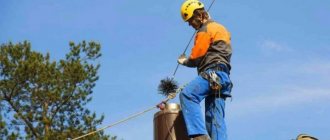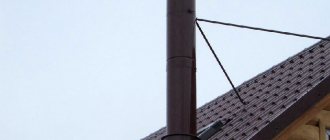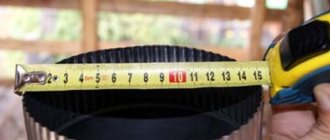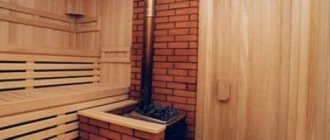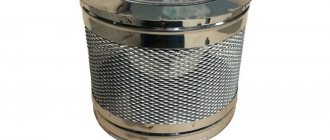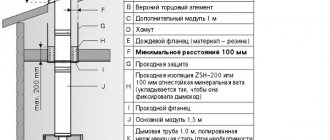How should a chimney be installed?
The chimney is an integral part of the heating system and its placement directly depends on the location of the heating device. The best location for the chimney system is inside the building. In such conditions, the chimney is protected from cold air, and the draft is not affected by wind surges, which makes it stable and optimal. It is best to bring the pipe outside under the very ridge of the roof in order to minimize atmospheric influences on the DS.
In the case when the heating operates constantly, for example, a gas boiler, then there is not much difference where the chimney will be placed - indoors or on the facade. And if the heating is not constant, for example, a stove or fireplace, then problems may arise with their operation. The fact is that the chimney does not generate heat and cannot heat itself. This function is assigned to the heating device. The chimney only needs to reliably and safely remove the flue gases that are formed due to the combustion of fuel to the outside.
Let's imagine a situation: the heating device is not functioning, and the chimney runs along the facade of the building. In this case, heated flue gases stop flowing into the smoke channel; they cool and freeze. And no matter what measures are taken to insulate the chimney (shaft equipment, increasing the thermal insulation layer), the temperature inside the chimney will be almost identical to the outside one.
Let's look at a simple example. Imagine a house under construction that already has walls and a roof, windows and doors installed, but no heating. So, no matter how thick and insulated the walls of the building are, the temperature in the room will be the same as outside.
Video description
What you need to know when choosing a sandwich chimney in the following video:
Ceramic chimney
For stainless steel chimneys, an important factor for flawless operation is high-quality thermal insulation between the sandwich layers. If a stainless steel pipe does not suit you, you can consider an alternative - a ceramic chimney with the following advantages:
- Ceramics is a material that has increased strength and is insensitive to intense heat (up to 1000°C).
Construction of a ceramic pipe Source stroiremdoma.ru
- Energy efficiency . Ceramics accumulate heat well and release it slowly. This property is especially valuable in a bathhouse, but it will also be useful in a residential building, where it will allow you to warm up, for example, an attic.
- Versatility . A ceramic pipe is connected to any stoves, fireplaces or boilers, regardless of the type of fuel.
- Durability . Ceramics are not afraid of temperature changes and chemical corrosion; soot is almost not retained on smooth internal surfaces (which also means high fire safety). Maintenance of such pipes will be minimal.
The downside is the high cost - such a design can hardly be called budget; Besides this, there are other disadvantages:
- Complex (sometimes poorly thought out) installation ; some manufacturers do not guarantee reliable operation.
Installation of ceramic pipes Source sckovcheg.ru
The danger of a cold chimney
An air lock often forms in a cold chimney - this is a layer of cold air located inside the channel. It is because of this plug that the flue gases cannot escape. As a result, the gases will flow back into the room, and the heating device will not turn on or simply will not melt.
Ilya ManaevTechnical specialist at Schiedel
It is important to know! If, when lighting a fireplace/stove, smoke comes into the room or the gas boiler does not turn on, then it means that the heating device does not have enough draft. This usually happens when the chimney is cold. To correct the situation, you need to warm up the smoke channel. Crumple up some paper and burn it in the firebox or chimney. Due to this, the internal channel of the chimney will warm up and the necessary draft will appear.
Another disadvantage of a cold chimney is the unstable operation of the heating-chimney connection. Thrust changes may occur, which will lead to significant excess fuel consumption. And also, a chimney running along the facade will produce more condensation than a pipe located indoors.
Attachment option
This type of connection of the chimney to the OP is conventionally called an economical option, since the installation of the entire system requires less fasteners when compared with other types of connections. Here the pipe stands and rests directly on the heating device. The connection is simple, but has serious drawbacks. In the mounted version, flue gases are removed by direct flow from the furnace. Because of this, excessive draft is created, which makes the fuel combustion process uneven and also increases its consumption.
Top-mounted chimney connection option
The next problem with a top-mount connection is condensate drainage. During the operation of heating devices, condensate forms, which must be removed from the firebox. Otherwise, condensation or moisture from atmospheric precipitation will fall directly into the firebox, which will lead to a reduction in its service life or destruction. And while a windproof umbrella will protect you from precipitation, there is practically no protection from moisture condensing in the channel.
Another disadvantage of a push-on connection is that it makes cleaning the chimney system more difficult. In this case, to clean the chimney, you need to dismantle the lower elements and securely fasten the upper part of the pipe. Another option is to remove soot from the firebox, if, of course, such a function is provided in the heating device. All this leads to an increase in the cost of cleaning and maintaining the diesel engine.
Wall and floor options
These types of connections are similar, except that the weight of the chimney is supported not by the heating device itself, but by fastening elements (console) located on the wall - this is a wall-mounted option. In the floor-standing version, the chimney stands on the floor.
Wall and floor-mounted chimney connection options
This connection option has significant advantages and also simplifies the operation of the chimney system and heating device:
Advantages of wall connection
Fire safety rules
When constructing chimneys, fire safety regulations must be strictly observed.
Particular attention is required to the chimney assembly diagram and the correct arrangement of the nodes for the passage of smoke exhaust channels through the ceilings and roof. You should also not overload solid fuel heating appliances with wood.
The chimney should be isolated from combustible structures by laying basalt insulation. If it is used for non-thermally insulated pipes, then the layer thickness is 300 millimeters; when brick or metal products are used, then 150 millimeters is sufficient.
Advantages and disadvantages of installing a steel chimney along the facade and indoors
The answer to the question why most people choose a steel chimney is simple:
Let's move on to the pros and cons of installing a chimney system outside and inside the building.
Ilya Manaev
Helpful information! Steel chimney systems are assembled without the use of sealants. All elements have socket connections. The DS parts are inserted into one another and crimped with a clamp. This guarantees tightness and high reliability of the system. Sealing compounds can only be used to connect the chimney and the heating device.
Advantages of installing a chimney on the facade:
- saving space indoors;
- DS cleaning takes place outdoors (no moisture or dirt);
- it is easier to install the chimney to the facade;
- there is no need to violate the integrity of the roof and ceilings.
Disadvantages of a chimney on the facade:
- if the heating device operates irregularly, an air lock may form in the internal chimney channel;
- a pipe running along the facade can reduce the aesthetic component of the building;
- Ice may form if proper condensate drainage is not organized;
- Single-wall chimneys cannot be used; only double-walled insulated steel chimneys are recommended.
Advantages of installing a chimney inside a building:
- optimal traction is created;
- the service life of the chimney is extended when compared with outdoor placement;
- no negative impact of wind loads and precipitation;
- the risk of damage to the chimney by third-party factors is minimized.
Disadvantages of a chimney indoors:
- during installation it is necessary to violate the integrity of the roof and ceilings;
- when the chimney is located in residential premises, cleaning and drainage of condensate is difficult;
- it is difficult to fix the DS to the mounting surface;
- the chimney may not fit into the design of the room.
Sandwich system kit details
Once the location of the chimney has been chosen, whether outdoors or indoors, you need to understand what parts will be needed to understand how to properly assemble the chimney. To compile a list of the necessary parts, you can independently contact a specialized store or request a commercial offer via the Internet. But it’s better if you have an independent understanding of the process and what parts will be useful during assembly.
Manufacturers produce chimneys with all the necessary components so that a full assembly cycle can be carried out. If there are differences between manufacturers' models, they relate to decorative or connecting functions. The list of elements is usually the same. Therefore, having decided on the names, you can choose a manufacturer based on the criteria of reliability or availability.
Sandwich chimney parts Source pech-kamin.ru
What to look for when installing steel chimney systems
Holes in ceilings, walls and roofs
When the installation parameters of the DS are determined (height, location, type of connection), you need to make holes in the ceiling, wall and roof. When making holes, it is necessary to take into account that the chimney will heat up during operation and this can lead to burns or fire. In this regard, it is necessary to strictly observe the clearances from combustible structures.
Ilya Manaev
It is important to know! Even if the chimney pipe passes through non-combustible structures, small gaps must be left, since the chimney system is a self-supporting independent structure. Its rigid fastening (clamping) to building structures is strictly prohibited!
Before installing the DS and making holes in the building structure, check the fire safety distances specified in the manufacturer's instructions. Russian standards state that the manufacturer of chimney systems must indicate safe distances to combustible structures.
SP 7.13130.2013 Heating, ventilation and air conditioning clause 5.27 The dimensions of grooves and offsets for heat-generating devices and factory-made smoke ducts should be taken in accordance with the technical documentation of the manufacturer.
But today, not every manufacturer can provide such information, and there are even fewer who can confirm it with certificates and test reports. By the presence of these documents, you can distinguish a bona fide chimney manufacturer from those who produce low-quality products.
Fireproof indentations
Roof connection and passage
The most important task during the installation of the chimney is to make a high-quality and hermetically sealed connection between the roof and the chimney. Errors when connecting and passing roofs are the most common on construction sites. Violation of the technological process at this stage leads to depressurization and leakage of the roof. Correcting these errors will result in additional costs.
Ilya Manaev
Important! Always ask the specialists how they perform the connection; what materials were used and why the craftsmen chose these particular materials; whether they followed the roofing and DS manufacturers' instructions. It wouldn’t hurt to ask the builders for a certificate of hidden work.
Fragment of instructions for joining
It is easier to make a correct joint on a rectangular shape than on a round one. Therefore, it is better to have a chimney located in the shaft pass through the roof. But for steel DS the presence of its own separate shaft is a rather rare case. And in such situations, the connection is made using special metal (preferably stainless or lead) or silicone roof passages (see Figure 6).
Metal and silicone roof penetrations
We hope that everyone understands: the first option is a more reliable, airtight and durable connection between the roof and the chimney. A silicone roof penetration is unlikely to withstand exposure to precipitation and sunlight for more than two to three years. Over time, its material will become softer and, one way or another, will shrink.
The option of making penetrations from steel (or lead for soft types of roofing) will last many times longer, and will also be more convenient during installation and will make it possible to make a more durable and airtight connection between the roof and the chimney.
Ilya Manaev
It is important to know! If the roof has a small slope, then when installing the chimney externally, you can bypass it or move the chimney vertical away from the wall using special elements of the chimney system - bends. (see Figure 7).
Bypassing the roof with bends
Briefly about the main thing
Installation of sandwich chimneys is carried out according to the assembly type of the designer.
The type of steel in the pipes must be selected depending on the fuel.
Installation can be done indoors or from the street.
The system can be assembled “by smoke” or “by condensate”.
You can do the installation yourself by preparing the necessary tools. During installation, special attention should be paid to the passage through the roof, walls and sealing the joints between parts.
Ratings 0
